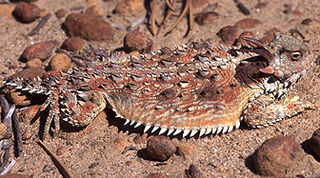
The Iguanidae is a family of lizards composed of the iguanas, chuckwallas, and their prehistoric relatives, including the widespread green iguana.

The greater earless lizard is the only species in the monotypic genus Cophosaurus. It is closely related to the smaller, lesser earless lizards and other species in the genus Holbrookia, and in fact was placed in that genus and referred to Holbrookia texana from 1852 into the 1970s. Earless lizards lack external ear openings, an adaptation to burrowing in the sand, as are the recessed lower jaw and flared upper labial scales. Greater earless lizards are sexually dimorphic, males grow larger and are more colorful than females, exhibiting pink and green colors that are particularly bright in the breeding season. Two bold black bars mark the lateral region of males but are greatly reduced and vague, or occasionally entirely absent in females.

Earless lizards are two genera of small lizards native to the semiarid and grassland habitats of the Southwestern United States and Mexico. The genus Cophosaurus and the genus Holbrookia are both characterized by having no external ear openings, presumably to prevent sand from entering their bodies as they dig.

Spiny lizards is a common name for the genus Sceloporus in the family Phrynosomatidae. The genus is endemic to North America, with various species ranging from New York, to Washington, and one occurring as far south as northern Panama. The greatest diversity is found in Mexico. This genus includes some of the most commonly seen lizards in the United States. Other common names for lizards in this genus include fence lizards, scaly lizards, bunchgrass lizards, and swifts.

The western fence lizard is a species of lizard native to Arizona, New Mexico, and California, as well as Idaho, Nevada, Oregon, Utah, Washington, and Northern Mexico. The species is widely found in its native range and is considered common, often being seen in yards, or as the name implies, on fences. As the ventral abdomen of an adult is characteristically blue, it is also known as the blue-belly. Two western fence lizards have been reported with duplicated or forked tails, presumably following an autotomy.

Holbrookia is a genus of earless lizards, known commonly as the lesser earless lizards, in the family Phrynosomatidae. The genus contains six recognized species, which are found throughout the Southwestern and Central United States and northern Mexico. They are characterized by having no external ear openings, presumably to prevent soil from entering their bodies when they are digging.

The northern alligator lizard is a species of medium-sized lizard in the family Anguidae. The species is endemic to the North American west coast.

Aspidoscelis is a genus of whiptail lizards in the family Teiidae.

The coast horned lizard is a species of phrynosomatid lizard endemic to Baja California Sur in Mexico. As a defense the lizard can shoot high pressure streams of blood out of its eyes if threatened.

Holbrookia maculata, commonly known as the lesser earless lizard, is a species of lizard in the family Phrynosomatidae. The species is native to the southwestern and central United States and northern Mexico. There are eight recognized subspecies.

Holbrookia propinqua, commonly known as the keeled earless lizard, is a species of phrynosomatid lizard.

Sceloporus grammicus is a species of lizard from Mexico and the southern United States. It is sometimes referred to as the mesquite lizard or graphic spiny lizard.
Holbrookia approximans, the speckled earless lizard, is a species of earless lizard which is found in the Southwestern United States and northern Mexico. It is sometimes referred to as the western earless lizard.
Holbrookia maculata perspicua, commonly known as the eastern earless lizard and the prairie earless lizard, is a subspecies of lizard in the family Phrynosomatidae. H. m. perspicua is a subspecies of the lesser earless lizard. The subspecies is native to the prairies of the central United States.












